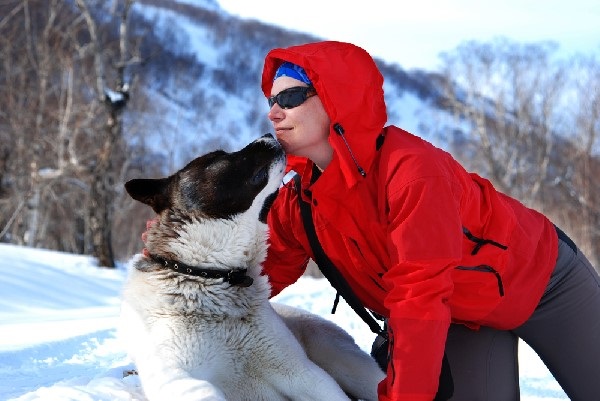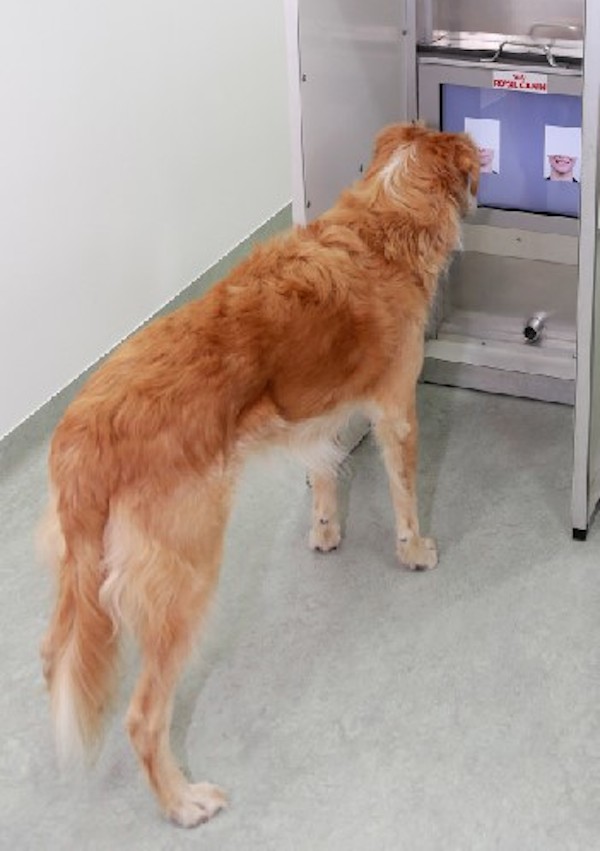Most dog owners have a sweet story about their pup comforting them when they’re sad — coming in for a snuggle or licking tears from a face — and also sharing in their joy through life’s most memorable moments. Now, research from the Clever Dog Lab in Vienna proves that dogs do in fact know when we’re happy and sad by reading our facial expressions.
The study was published in the journal Current Biology, and it confirms what all pet lovers have long suspected to be true: Dogs read our faces. The experiment used volunteer dogs, and it involved them recognizing happy and angry expressions based on just half of a human’s face. Of course, we all know that canines use their keen ears and noses to process auditory and olfactory information with incredible success. This line of research wanted to find out whether they are also skilled at reading visual cues. Surprisingly, the dogs were quite good at it.
Dogs were shown pictures of half of a human face on a touchscreen monitor. The face was either happy or sad. They were then shown the other half of the face with both happy and sad options, and were rewarded when they touched the correct corresponding photo with their nose. In essence, the dogs were discriminating between two expressions, although it cannot be assumed that they recognize the emotional expression itself.
Whether that competence is innate (a consequence of domestication over 15,000 years) or a result of learning through experience is unclear. All of the dogs used in the study were household pets with owners who doubtlessly used facial expressions on a regular basis. Still, the findings indicate that dogs use their visual sense much more skillfully than we thought. Especially since the test subjects were only exposed to two-dimensional photos, as opposed to in-person human interaction.
“Dogs exploit all kinds of information using all their senses,” says Professor Ludwig Huber, senior author and head of the group at the University of Veterinary Medicine Vienna’s Messerli Research Institute. “And different parts of the face are informative.”
As a dog owner, this got me thinking. What about when I’m wearing sunglasses and my dog can’t see my eyes? Or during the winter, when I bundle up with a neck warmer that covers my mouth?
“We have a study where we showed just small parts of the face — only the eyes, nose, or mouth. The task was to discriminate between different people only on that basis, and the dogs can do it,” Huber says. In yet another study, people wore hoods, or balaclava, that covered the forehead, chin, and ears. Only the eyes, mouth, and nose, were visible. “Several dogs were very confused and couldn’t identify the owner, but others didn’t have trouble,” Huber adds.

“If covering parts of the face confuses a dog, I expect this will be only temporary,” says Dr. Corsin Müller, a cognitive biologist at the Messerli Research Institute at the University of Veterinary Medicine Vienna, who, along with a group of colleagues, helped Dr. Huber conduct the research. “It may lead to slightly slower recognition or responses to commands.”
Regardless, it’s clear that at least some dogs can discriminate between happy and angry facial expressions in humans even when the faces are unfamiliar and appear on a flat screen. However the wider implications of this finding are still unknown. Although the dogs rewarded for touching the angry faces took longer in their response time, we still can’t be sure that dogs know that a furrowed brow is a bad thing and a smile is good.
No matter what her level of understanding may be, my dog will continue to field a whole range of facial expressions from me in an attempt to get more attuned to my intentions. Naturally, I wondered if the results of this research meant that I should change my training tactics and focus on visual as opposed to verbal cues.
“We are still very much at the beginning of understanding what information dogs extract from human faces. So it would be premature to change training procedures because of our findings,” Müller stressed. “The only thing our study, together with some other studies, may suggest is that dogs, despite their limited visual abilities, perceive more relevant information with their eyes than some people may have thought.”

Point taken. Still, I find the research fascinating because it’s the first time that dogs have proven to read the facial expressions of another species.
“A recent study by Japanese colleagues also suggested that dogs may be able to discriminate different facial expressions. Their results were not entirely conclusive, however, which is why we wanted to perform a more stringent test of this question,” Müller says. There’s been other research confirming this truism, but these most recent findings are incredibly powerful, especially because the dogs were never shown a whole face. In fact, the dogs shown the bottom half of faces during training were shown the top half during the test phase.”
She adds, “These dogs seemed to realize that smiling eyes have the same meaning as a smiling mouth, and vice versa, that angry eyes have the same meaning as an angry mouth.”
Armed with this new knowledge, it would seem logical that further studies need to be done to see what else our four-legged friends are capable of doing. According to Huber, that’s the plan — to see if dogs can generalize this kind of skill to other faces, such as babies and other ethnicities, then to which they’re accustomed.
“Dogs have special attentiveness towards human emotions or faces, so the natural comparison would be with wolves,” Huber says.
The university actually has a group of wolves raised by humans, so they have the same socialization experiences as dogs, but they didn’t undergo the domestication process. This means that if the wolves can’t read faces, then it’s thousands of years of domestication that might be responsible for the special skill in dogs. If, however, wolves can distinguish emotion in human faces, then perhaps it’s raising them along our side that does the trick.
I think I’ll leave the wolf training to the experts.
Read more about dogs and science on Dogster:
- Science Says That There Really is Love in Those Puppy Dog Eyes
- Frankie the German Shepherd Can Sniff Out Thyroid Cancer
- Do You Deceive Your Dog? Study Shows He Knows When You Lie
Featured Image Credit: Pereslavtseva Katerina, Shutterstock










